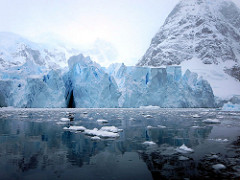Greenland’s Disappearing Ice Sheets

February 8, 2016
The National Geographic predicts that by the year 2100, global sea levels will rise by 6.5 feet. This seemingly small increase will submerge low-elevation cities all over the world, including many cities on the United States’ East Coast.
Rapidly melting ice sheets–masses of glacial ice that span at least 50,000 square kilometers–are the main contributors to rising ocean levels. Greenland’s ice sheets are a major source of concern, with an average of 287 billion metric tons of ice melting annually. Over the last century, trillions of tons of water have melted from the Greenland ice sheets. If the remaining ice in Greenland were to melt, the oceans would rise by 21 feet.
It is natural for ice sheets to melt in tandem with yearly seasonal changes. However, meltwater used to be reabsorbed into glaciers through a porous ice layer know as the firn. This process was disrupted by extreme melts, which caused a layer of thick ice to form over the firn. Now, instead of being reabsorbed, meltwater is forced to flow over the ice and drain into the ocean.
In the last decade, the flow has increased dramatically. A study released on January 12th by the Belgian University of Leuven reveals that clouds are responsible for 30% of the melt. Clouds pose a double threat to the ice sheets because they reflect light back on to the ice, magnifying the warming effect caused by sunlight. They also trap heat in the atmosphere, warming the air over the ice sheets.
Researcher Gordon Hamilton of the University of Maine has found that warm water surrounding the glaciers is also contributing to the melting. His research found that at a depth of 2000 feet, water surrounding the glaciers measured 4.04°C. Salt water requires a temperature of -2°C to freeze. This warm water is a likely cause of the rapid melting and destabilization of Greenland’s glaciers.
Water from the southern Atlantic Ocean circulates near Greenland. Due to warming from greenhouse gas emissions, this water has been warmer than usual. The warm water carves out vast troughs in the ice, exposing even more of the glaciers to the warm water and causing massive damage to the Greenland fjords.
In the coming decades, the rising ocean levels will affect hundreds of millions of people. There is a great need for further research that will allow us to protect homes and businesses in low-elevation coastal cities. Ultimately, we will have change our lifestyles–either by moving to high-elevation cities or by adopting more environmentally-friendly practices. If we act now, the changes will be our own choice. If we wait, the ocean will force us to abandon our homes. The choice is clear.


